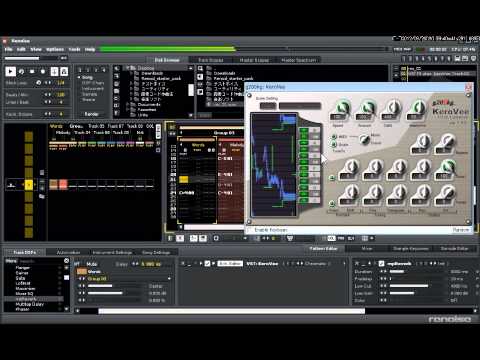Hi all,
now I’m glad to introduce this new (and a little strange) contents called “Renoid”. ![]()
At the beginning of September, YAMAHA announced “VOCALOID Editor for Cubase”.
And I read a someone’s request somewhere like “I want to use this Editor in Renoise !!”. Of course, it was almost a joking though… ![]()
But I thought of an another method to realize the virtual singer in Renoise.
This post is the first announcement about it.
Well, actually Renoid is not a new feature, it’s just a combination of existing functions of Renoise. Let me explain a bit.
-
- Renoid voice file is just a XRNI file which includes japanese HIRAGANA wav files (So currently, Renoid is quite japanese-oriented contents). This XRNI file is not for making melody, this is for “Words”.
-
- Renoid needs pitch shifter VST like KeroVee, Pitchwheel, Auto-Tune, etc. It depends on such external plugin heavily.
This is a weak point of this system. But if you are a Windows user, there is an excellent free VST “KeroVee”.
- Renoid needs pitch shifter VST like KeroVee, Pitchwheel, Auto-Tune, etc. It depends on such external plugin heavily.
-
- These pitch shifter VST can recognize MIDI note signal from another track. So, make a track for words and a track for melody separately.
-
- Then insert the pitch shifter VST to the words-track, and send the melody midi signal from melody-track by using “VST FX Alias”.
-
- The result is, you can listen to somewhat funny singing voice. It’s not very high quality like VOCALOID, but you can find some interesting uses, I hope.
Btw, about Renoid English version, unfortunately I cannot make such XRNI file since I’m poor at English. Even I cannot imagine how to make such English speaking XRNI ![]() . But someone here may get interested in making it.
. But someone here may get interested in making it.
So I’ve made some YouTube movies which explain how-to use and how-to make Renoid voice file. Also I made demo song and Renoid starter pack too. These contents are made for japanese people mainly, but I prepared some captions for YouTube movies, so I hope it may help to understand Renoid system easily.
How-to use Renoid (with English caption)
[indent]
[/indent]
How-to make Renoid voice file (with English caption)
[indent]
[/indent]
Renoid starter pack
[indent]http://reg.s63.xrea.com/Renoid/Renoid_starter_pack_v11.zip[/indent]
And, Renoid homepage (includes all contents)
http://reg.s63.xrea.com/Renoid/
![]() [1 attention]
[1 attention]
Please remember that if you make a Renoid file by sampling from YAMAHA’s VOCALOID products, it is usable only for your personal use. It is not allowed to share it to another person, as XRNS or XRNI. So, I recommend to record your own or friend’s voice.
That’s all. Hope you enjoy Renoid!! ![]()


